Comprehensive Report on the Sydney Light Rail Network Development
VerifiedAdded on 2020/03/16
|8
|2529
|104
Report
AI Summary
This report provides a comprehensive overview of the Sydney Light Rail network in Sydney, Australia. It begins with an introduction highlighting the network's innovative design, extensive route, and positive impact on public transport, including its high-frequency services and customer satisfaction. The preliminary design phase is discussed, detailing the network's control by the New South Wales government, its role in reducing traffic congestion, and the use of gauge tracks and electric current. The detailed design and development section explores the transformation of the public domain, the role of HASSELL in the design, and the creation of a sustainable and efficient urban environment. The system test, evaluation, validation, and optimization aspects are presented, including the testing phase in France, passenger capacity, and energy efficiency. The report concludes by summarizing the network's benefits in reducing traffic, accommodating a large number of passengers, and contributing to a greener and more sustainable urban environment.

1
System Science Engineering
<Student ID>
<Student Name>
<University Name>
System Science Engineering
<Student ID>
<Student Name>
<University Name>
Paraphrase This Document
Need a fresh take? Get an instant paraphrase of this document with our AI Paraphraser

2
Contents
Introduction......................................................................................................................................3
Preliminary design...........................................................................................................................3
Detailed design and development of the network............................................................................4
System test, evaluation, validation and optimization......................................................................5
Conclusion.......................................................................................................................................6
References........................................................................................................................................7
Contents
Introduction......................................................................................................................................3
Preliminary design...........................................................................................................................3
Detailed design and development of the network............................................................................4
System test, evaluation, validation and optimization......................................................................5
Conclusion.......................................................................................................................................6
References........................................................................................................................................7
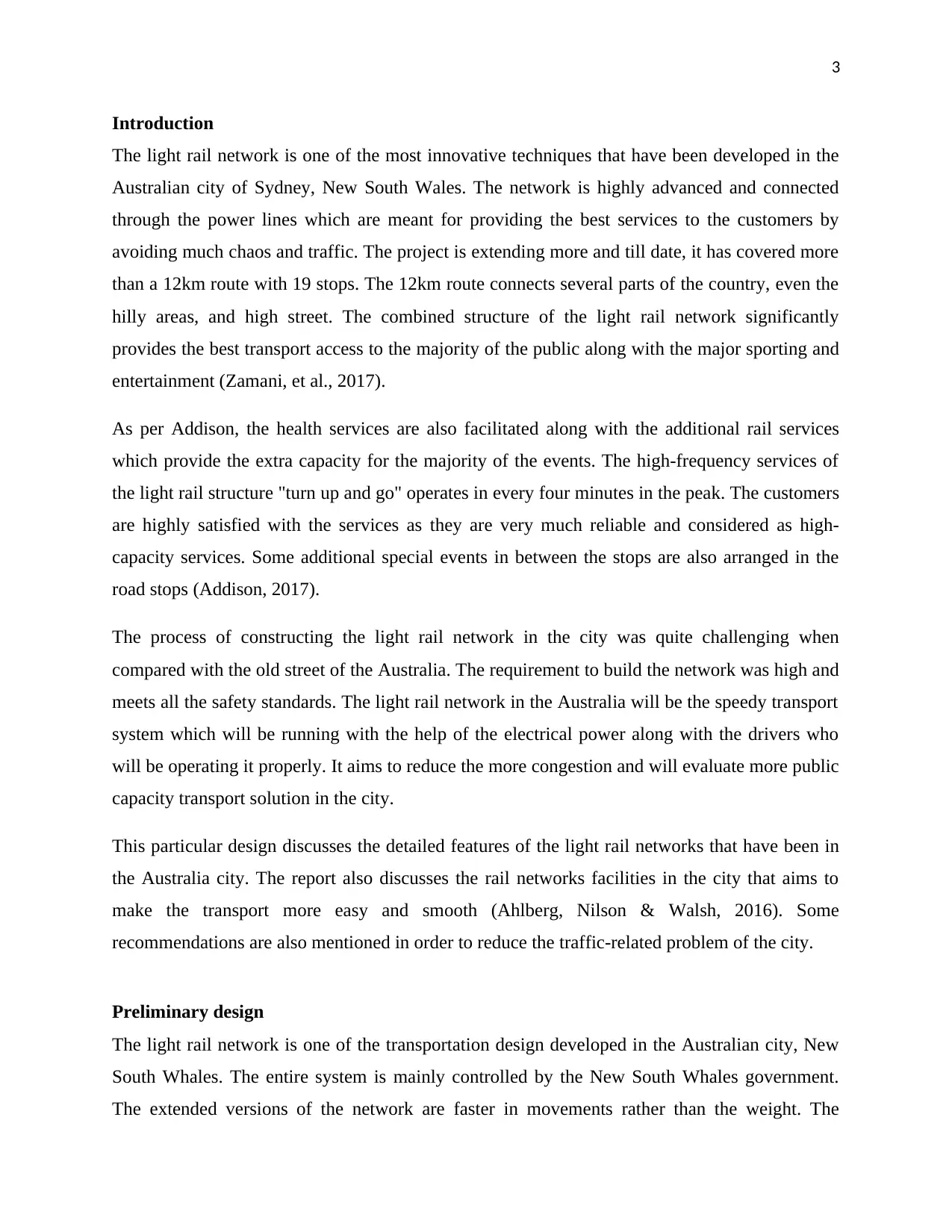
3
Introduction
The light rail network is one of the most innovative techniques that have been developed in the
Australian city of Sydney, New South Wales. The network is highly advanced and connected
through the power lines which are meant for providing the best services to the customers by
avoiding much chaos and traffic. The project is extending more and till date, it has covered more
than a 12km route with 19 stops. The 12km route connects several parts of the country, even the
hilly areas, and high street. The combined structure of the light rail network significantly
provides the best transport access to the majority of the public along with the major sporting and
entertainment (Zamani, et al., 2017).
As per Addison, the health services are also facilitated along with the additional rail services
which provide the extra capacity for the majority of the events. The high-frequency services of
the light rail structure "turn up and go" operates in every four minutes in the peak. The customers
are highly satisfied with the services as they are very much reliable and considered as high-
capacity services. Some additional special events in between the stops are also arranged in the
road stops (Addison, 2017).
The process of constructing the light rail network in the city was quite challenging when
compared with the old street of the Australia. The requirement to build the network was high and
meets all the safety standards. The light rail network in the Australia will be the speedy transport
system which will be running with the help of the electrical power along with the drivers who
will be operating it properly. It aims to reduce the more congestion and will evaluate more public
capacity transport solution in the city.
This particular design discusses the detailed features of the light rail networks that have been in
the Australia city. The report also discusses the rail networks facilities in the city that aims to
make the transport more easy and smooth (Ahlberg, Nilson & Walsh, 2016). Some
recommendations are also mentioned in order to reduce the traffic-related problem of the city.
Preliminary design
The light rail network is one of the transportation design developed in the Australian city, New
South Whales. The entire system is mainly controlled by the New South Whales government.
The extended versions of the network are faster in movements rather than the weight. The
Introduction
The light rail network is one of the most innovative techniques that have been developed in the
Australian city of Sydney, New South Wales. The network is highly advanced and connected
through the power lines which are meant for providing the best services to the customers by
avoiding much chaos and traffic. The project is extending more and till date, it has covered more
than a 12km route with 19 stops. The 12km route connects several parts of the country, even the
hilly areas, and high street. The combined structure of the light rail network significantly
provides the best transport access to the majority of the public along with the major sporting and
entertainment (Zamani, et al., 2017).
As per Addison, the health services are also facilitated along with the additional rail services
which provide the extra capacity for the majority of the events. The high-frequency services of
the light rail structure "turn up and go" operates in every four minutes in the peak. The customers
are highly satisfied with the services as they are very much reliable and considered as high-
capacity services. Some additional special events in between the stops are also arranged in the
road stops (Addison, 2017).
The process of constructing the light rail network in the city was quite challenging when
compared with the old street of the Australia. The requirement to build the network was high and
meets all the safety standards. The light rail network in the Australia will be the speedy transport
system which will be running with the help of the electrical power along with the drivers who
will be operating it properly. It aims to reduce the more congestion and will evaluate more public
capacity transport solution in the city.
This particular design discusses the detailed features of the light rail networks that have been in
the Australia city. The report also discusses the rail networks facilities in the city that aims to
make the transport more easy and smooth (Ahlberg, Nilson & Walsh, 2016). Some
recommendations are also mentioned in order to reduce the traffic-related problem of the city.
Preliminary design
The light rail network is one of the transportation design developed in the Australian city, New
South Whales. The entire system is mainly controlled by the New South Whales government.
The extended versions of the network are faster in movements rather than the weight. The
⊘ This is a preview!⊘
Do you want full access?
Subscribe today to unlock all pages.

Trusted by 1+ million students worldwide
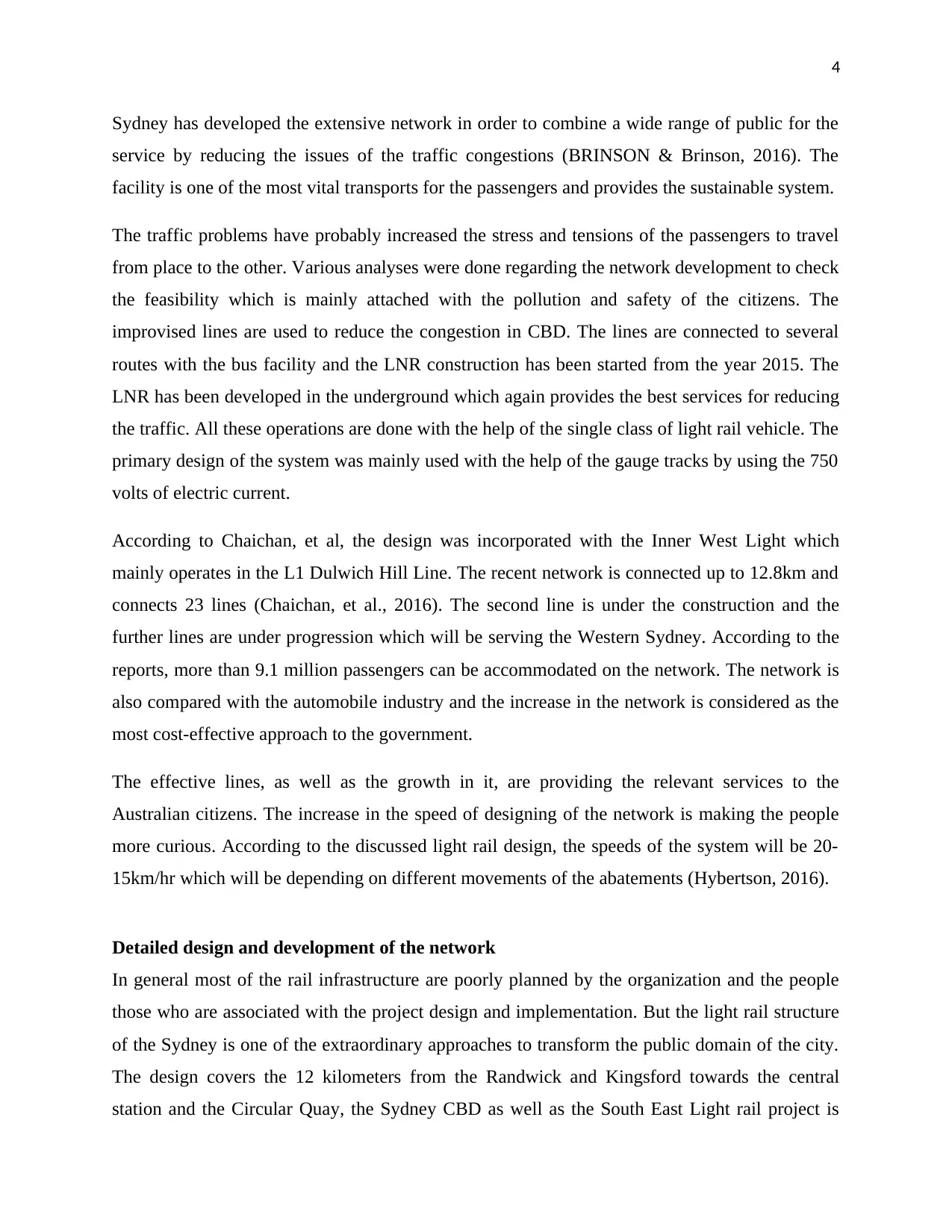
4
Sydney has developed the extensive network in order to combine a wide range of public for the
service by reducing the issues of the traffic congestions (BRINSON & Brinson, 2016). The
facility is one of the most vital transports for the passengers and provides the sustainable system.
The traffic problems have probably increased the stress and tensions of the passengers to travel
from place to the other. Various analyses were done regarding the network development to check
the feasibility which is mainly attached with the pollution and safety of the citizens. The
improvised lines are used to reduce the congestion in CBD. The lines are connected to several
routes with the bus facility and the LNR construction has been started from the year 2015. The
LNR has been developed in the underground which again provides the best services for reducing
the traffic. All these operations are done with the help of the single class of light rail vehicle. The
primary design of the system was mainly used with the help of the gauge tracks by using the 750
volts of electric current.
According to Chaichan, et al, the design was incorporated with the Inner West Light which
mainly operates in the L1 Dulwich Hill Line. The recent network is connected up to 12.8km and
connects 23 lines (Chaichan, et al., 2016). The second line is under the construction and the
further lines are under progression which will be serving the Western Sydney. According to the
reports, more than 9.1 million passengers can be accommodated on the network. The network is
also compared with the automobile industry and the increase in the network is considered as the
most cost-effective approach to the government.
The effective lines, as well as the growth in it, are providing the relevant services to the
Australian citizens. The increase in the speed of designing of the network is making the people
more curious. According to the discussed light rail design, the speeds of the system will be 20-
15km/hr which will be depending on different movements of the abatements (Hybertson, 2016).
Detailed design and development of the network
In general most of the rail infrastructure are poorly planned by the organization and the people
those who are associated with the project design and implementation. But the light rail structure
of the Sydney is one of the extraordinary approaches to transform the public domain of the city.
The design covers the 12 kilometers from the Randwick and Kingsford towards the central
station and the Circular Quay, the Sydney CBD as well as the South East Light rail project is
Sydney has developed the extensive network in order to combine a wide range of public for the
service by reducing the issues of the traffic congestions (BRINSON & Brinson, 2016). The
facility is one of the most vital transports for the passengers and provides the sustainable system.
The traffic problems have probably increased the stress and tensions of the passengers to travel
from place to the other. Various analyses were done regarding the network development to check
the feasibility which is mainly attached with the pollution and safety of the citizens. The
improvised lines are used to reduce the congestion in CBD. The lines are connected to several
routes with the bus facility and the LNR construction has been started from the year 2015. The
LNR has been developed in the underground which again provides the best services for reducing
the traffic. All these operations are done with the help of the single class of light rail vehicle. The
primary design of the system was mainly used with the help of the gauge tracks by using the 750
volts of electric current.
According to Chaichan, et al, the design was incorporated with the Inner West Light which
mainly operates in the L1 Dulwich Hill Line. The recent network is connected up to 12.8km and
connects 23 lines (Chaichan, et al., 2016). The second line is under the construction and the
further lines are under progression which will be serving the Western Sydney. According to the
reports, more than 9.1 million passengers can be accommodated on the network. The network is
also compared with the automobile industry and the increase in the network is considered as the
most cost-effective approach to the government.
The effective lines, as well as the growth in it, are providing the relevant services to the
Australian citizens. The increase in the speed of designing of the network is making the people
more curious. According to the discussed light rail design, the speeds of the system will be 20-
15km/hr which will be depending on different movements of the abatements (Hybertson, 2016).
Detailed design and development of the network
In general most of the rail infrastructure are poorly planned by the organization and the people
those who are associated with the project design and implementation. But the light rail structure
of the Sydney is one of the extraordinary approaches to transform the public domain of the city.
The design covers the 12 kilometers from the Randwick and Kingsford towards the central
station and the Circular Quay, the Sydney CBD as well as the South East Light rail project is
Paraphrase This Document
Need a fresh take? Get an instant paraphrase of this document with our AI Paraphraser
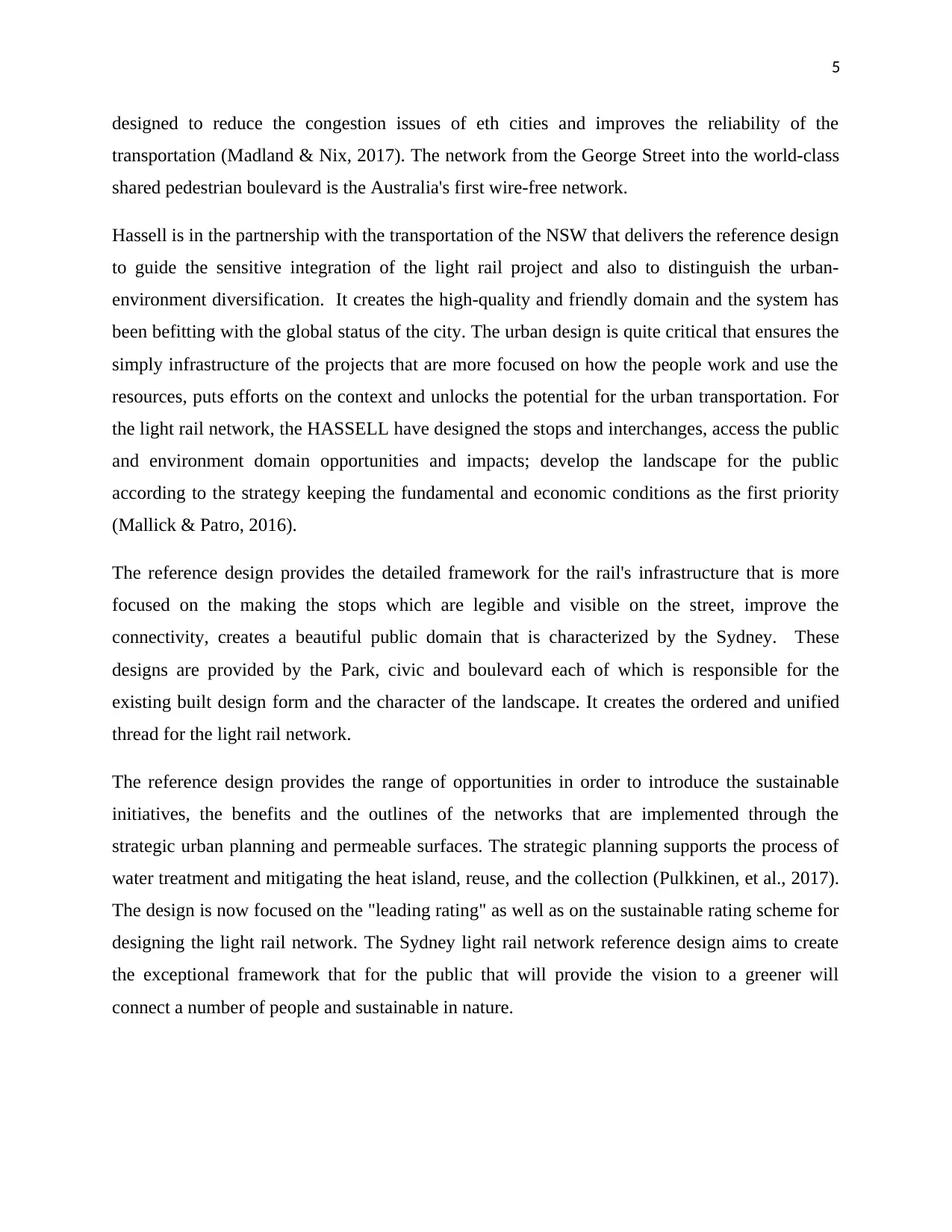
5
designed to reduce the congestion issues of eth cities and improves the reliability of the
transportation (Madland & Nix, 2017). The network from the George Street into the world-class
shared pedestrian boulevard is the Australia's first wire-free network.
Hassell is in the partnership with the transportation of the NSW that delivers the reference design
to guide the sensitive integration of the light rail project and also to distinguish the urban-
environment diversification. It creates the high-quality and friendly domain and the system has
been befitting with the global status of the city. The urban design is quite critical that ensures the
simply infrastructure of the projects that are more focused on how the people work and use the
resources, puts efforts on the context and unlocks the potential for the urban transportation. For
the light rail network, the HASSELL have designed the stops and interchanges, access the public
and environment domain opportunities and impacts; develop the landscape for the public
according to the strategy keeping the fundamental and economic conditions as the first priority
(Mallick & Patro, 2016).
The reference design provides the detailed framework for the rail's infrastructure that is more
focused on the making the stops which are legible and visible on the street, improve the
connectivity, creates a beautiful public domain that is characterized by the Sydney. These
designs are provided by the Park, civic and boulevard each of which is responsible for the
existing built design form and the character of the landscape. It creates the ordered and unified
thread for the light rail network.
The reference design provides the range of opportunities in order to introduce the sustainable
initiatives, the benefits and the outlines of the networks that are implemented through the
strategic urban planning and permeable surfaces. The strategic planning supports the process of
water treatment and mitigating the heat island, reuse, and the collection (Pulkkinen, et al., 2017).
The design is now focused on the "leading rating" as well as on the sustainable rating scheme for
designing the light rail network. The Sydney light rail network reference design aims to create
the exceptional framework that for the public that will provide the vision to a greener will
connect a number of people and sustainable in nature.
designed to reduce the congestion issues of eth cities and improves the reliability of the
transportation (Madland & Nix, 2017). The network from the George Street into the world-class
shared pedestrian boulevard is the Australia's first wire-free network.
Hassell is in the partnership with the transportation of the NSW that delivers the reference design
to guide the sensitive integration of the light rail project and also to distinguish the urban-
environment diversification. It creates the high-quality and friendly domain and the system has
been befitting with the global status of the city. The urban design is quite critical that ensures the
simply infrastructure of the projects that are more focused on how the people work and use the
resources, puts efforts on the context and unlocks the potential for the urban transportation. For
the light rail network, the HASSELL have designed the stops and interchanges, access the public
and environment domain opportunities and impacts; develop the landscape for the public
according to the strategy keeping the fundamental and economic conditions as the first priority
(Mallick & Patro, 2016).
The reference design provides the detailed framework for the rail's infrastructure that is more
focused on the making the stops which are legible and visible on the street, improve the
connectivity, creates a beautiful public domain that is characterized by the Sydney. These
designs are provided by the Park, civic and boulevard each of which is responsible for the
existing built design form and the character of the landscape. It creates the ordered and unified
thread for the light rail network.
The reference design provides the range of opportunities in order to introduce the sustainable
initiatives, the benefits and the outlines of the networks that are implemented through the
strategic urban planning and permeable surfaces. The strategic planning supports the process of
water treatment and mitigating the heat island, reuse, and the collection (Pulkkinen, et al., 2017).
The design is now focused on the "leading rating" as well as on the sustainable rating scheme for
designing the light rail network. The Sydney light rail network reference design aims to create
the exceptional framework that for the public that will provide the vision to a greener will
connect a number of people and sustainable in nature.
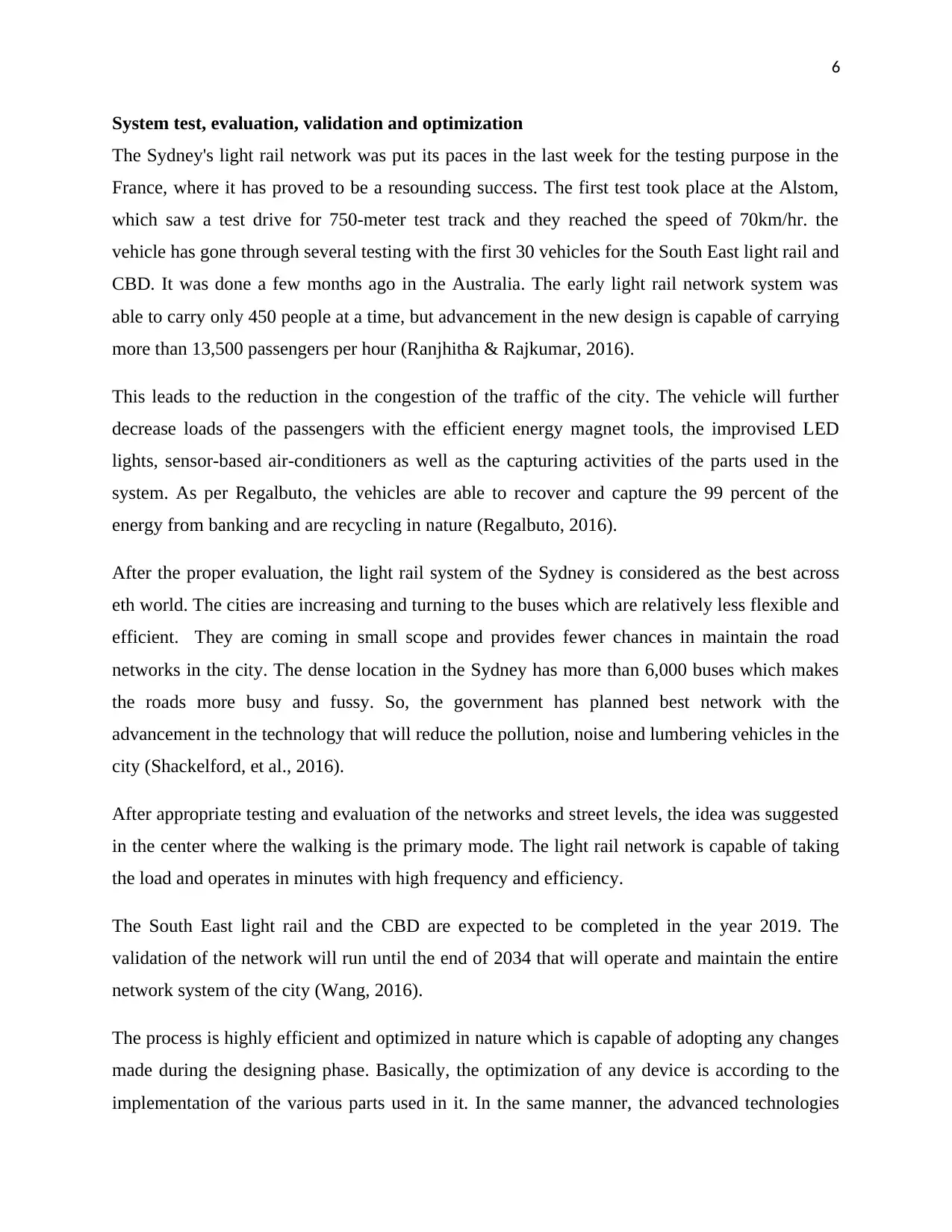
6
System test, evaluation, validation and optimization
The Sydney's light rail network was put its paces in the last week for the testing purpose in the
France, where it has proved to be a resounding success. The first test took place at the Alstom,
which saw a test drive for 750-meter test track and they reached the speed of 70km/hr. the
vehicle has gone through several testing with the first 30 vehicles for the South East light rail and
CBD. It was done a few months ago in the Australia. The early light rail network system was
able to carry only 450 people at a time, but advancement in the new design is capable of carrying
more than 13,500 passengers per hour (Ranjhitha & Rajkumar, 2016).
This leads to the reduction in the congestion of the traffic of the city. The vehicle will further
decrease loads of the passengers with the efficient energy magnet tools, the improvised LED
lights, sensor-based air-conditioners as well as the capturing activities of the parts used in the
system. As per Regalbuto, the vehicles are able to recover and capture the 99 percent of the
energy from banking and are recycling in nature (Regalbuto, 2016).
After the proper evaluation, the light rail system of the Sydney is considered as the best across
eth world. The cities are increasing and turning to the buses which are relatively less flexible and
efficient. They are coming in small scope and provides fewer chances in maintain the road
networks in the city. The dense location in the Sydney has more than 6,000 buses which makes
the roads more busy and fussy. So, the government has planned best network with the
advancement in the technology that will reduce the pollution, noise and lumbering vehicles in the
city (Shackelford, et al., 2016).
After appropriate testing and evaluation of the networks and street levels, the idea was suggested
in the center where the walking is the primary mode. The light rail network is capable of taking
the load and operates in minutes with high frequency and efficiency.
The South East light rail and the CBD are expected to be completed in the year 2019. The
validation of the network will run until the end of 2034 that will operate and maintain the entire
network system of the city (Wang, 2016).
The process is highly efficient and optimized in nature which is capable of adopting any changes
made during the designing phase. Basically, the optimization of any device is according to the
implementation of the various parts used in it. In the same manner, the advanced technologies
System test, evaluation, validation and optimization
The Sydney's light rail network was put its paces in the last week for the testing purpose in the
France, where it has proved to be a resounding success. The first test took place at the Alstom,
which saw a test drive for 750-meter test track and they reached the speed of 70km/hr. the
vehicle has gone through several testing with the first 30 vehicles for the South East light rail and
CBD. It was done a few months ago in the Australia. The early light rail network system was
able to carry only 450 people at a time, but advancement in the new design is capable of carrying
more than 13,500 passengers per hour (Ranjhitha & Rajkumar, 2016).
This leads to the reduction in the congestion of the traffic of the city. The vehicle will further
decrease loads of the passengers with the efficient energy magnet tools, the improvised LED
lights, sensor-based air-conditioners as well as the capturing activities of the parts used in the
system. As per Regalbuto, the vehicles are able to recover and capture the 99 percent of the
energy from banking and are recycling in nature (Regalbuto, 2016).
After the proper evaluation, the light rail system of the Sydney is considered as the best across
eth world. The cities are increasing and turning to the buses which are relatively less flexible and
efficient. They are coming in small scope and provides fewer chances in maintain the road
networks in the city. The dense location in the Sydney has more than 6,000 buses which makes
the roads more busy and fussy. So, the government has planned best network with the
advancement in the technology that will reduce the pollution, noise and lumbering vehicles in the
city (Shackelford, et al., 2016).
After appropriate testing and evaluation of the networks and street levels, the idea was suggested
in the center where the walking is the primary mode. The light rail network is capable of taking
the load and operates in minutes with high frequency and efficiency.
The South East light rail and the CBD are expected to be completed in the year 2019. The
validation of the network will run until the end of 2034 that will operate and maintain the entire
network system of the city (Wang, 2016).
The process is highly efficient and optimized in nature which is capable of adopting any changes
made during the designing phase. Basically, the optimization of any device is according to the
implementation of the various parts used in it. In the same manner, the advanced technologies
⊘ This is a preview!⊘
Do you want full access?
Subscribe today to unlock all pages.

Trusted by 1+ million students worldwide
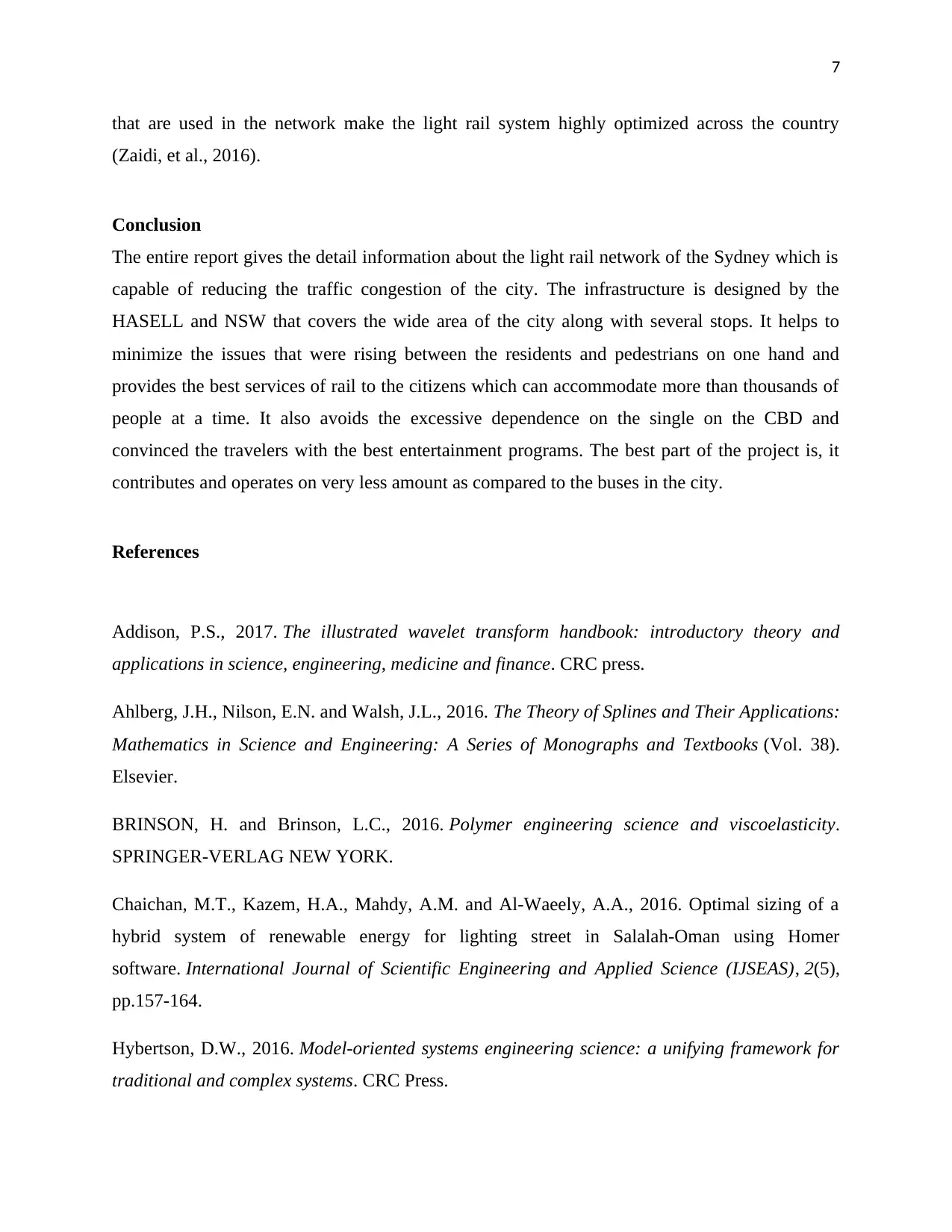
7
that are used in the network make the light rail system highly optimized across the country
(Zaidi, et al., 2016).
Conclusion
The entire report gives the detail information about the light rail network of the Sydney which is
capable of reducing the traffic congestion of the city. The infrastructure is designed by the
HASELL and NSW that covers the wide area of the city along with several stops. It helps to
minimize the issues that were rising between the residents and pedestrians on one hand and
provides the best services of rail to the citizens which can accommodate more than thousands of
people at a time. It also avoids the excessive dependence on the single on the CBD and
convinced the travelers with the best entertainment programs. The best part of the project is, it
contributes and operates on very less amount as compared to the buses in the city.
References
Addison, P.S., 2017. The illustrated wavelet transform handbook: introductory theory and
applications in science, engineering, medicine and finance. CRC press.
Ahlberg, J.H., Nilson, E.N. and Walsh, J.L., 2016. The Theory of Splines and Their Applications:
Mathematics in Science and Engineering: A Series of Monographs and Textbooks (Vol. 38).
Elsevier.
BRINSON, H. and Brinson, L.C., 2016. Polymer engineering science and viscoelasticity.
SPRINGER-VERLAG NEW YORK.
Chaichan, M.T., Kazem, H.A., Mahdy, A.M. and Al-Waeely, A.A., 2016. Optimal sizing of a
hybrid system of renewable energy for lighting street in Salalah-Oman using Homer
software. International Journal of Scientific Engineering and Applied Science (IJSEAS), 2(5),
pp.157-164.
Hybertson, D.W., 2016. Model-oriented systems engineering science: a unifying framework for
traditional and complex systems. CRC Press.
that are used in the network make the light rail system highly optimized across the country
(Zaidi, et al., 2016).
Conclusion
The entire report gives the detail information about the light rail network of the Sydney which is
capable of reducing the traffic congestion of the city. The infrastructure is designed by the
HASELL and NSW that covers the wide area of the city along with several stops. It helps to
minimize the issues that were rising between the residents and pedestrians on one hand and
provides the best services of rail to the citizens which can accommodate more than thousands of
people at a time. It also avoids the excessive dependence on the single on the CBD and
convinced the travelers with the best entertainment programs. The best part of the project is, it
contributes and operates on very less amount as compared to the buses in the city.
References
Addison, P.S., 2017. The illustrated wavelet transform handbook: introductory theory and
applications in science, engineering, medicine and finance. CRC press.
Ahlberg, J.H., Nilson, E.N. and Walsh, J.L., 2016. The Theory of Splines and Their Applications:
Mathematics in Science and Engineering: A Series of Monographs and Textbooks (Vol. 38).
Elsevier.
BRINSON, H. and Brinson, L.C., 2016. Polymer engineering science and viscoelasticity.
SPRINGER-VERLAG NEW YORK.
Chaichan, M.T., Kazem, H.A., Mahdy, A.M. and Al-Waeely, A.A., 2016. Optimal sizing of a
hybrid system of renewable energy for lighting street in Salalah-Oman using Homer
software. International Journal of Scientific Engineering and Applied Science (IJSEAS), 2(5),
pp.157-164.
Hybertson, D.W., 2016. Model-oriented systems engineering science: a unifying framework for
traditional and complex systems. CRC Press.
Paraphrase This Document
Need a fresh take? Get an instant paraphrase of this document with our AI Paraphraser
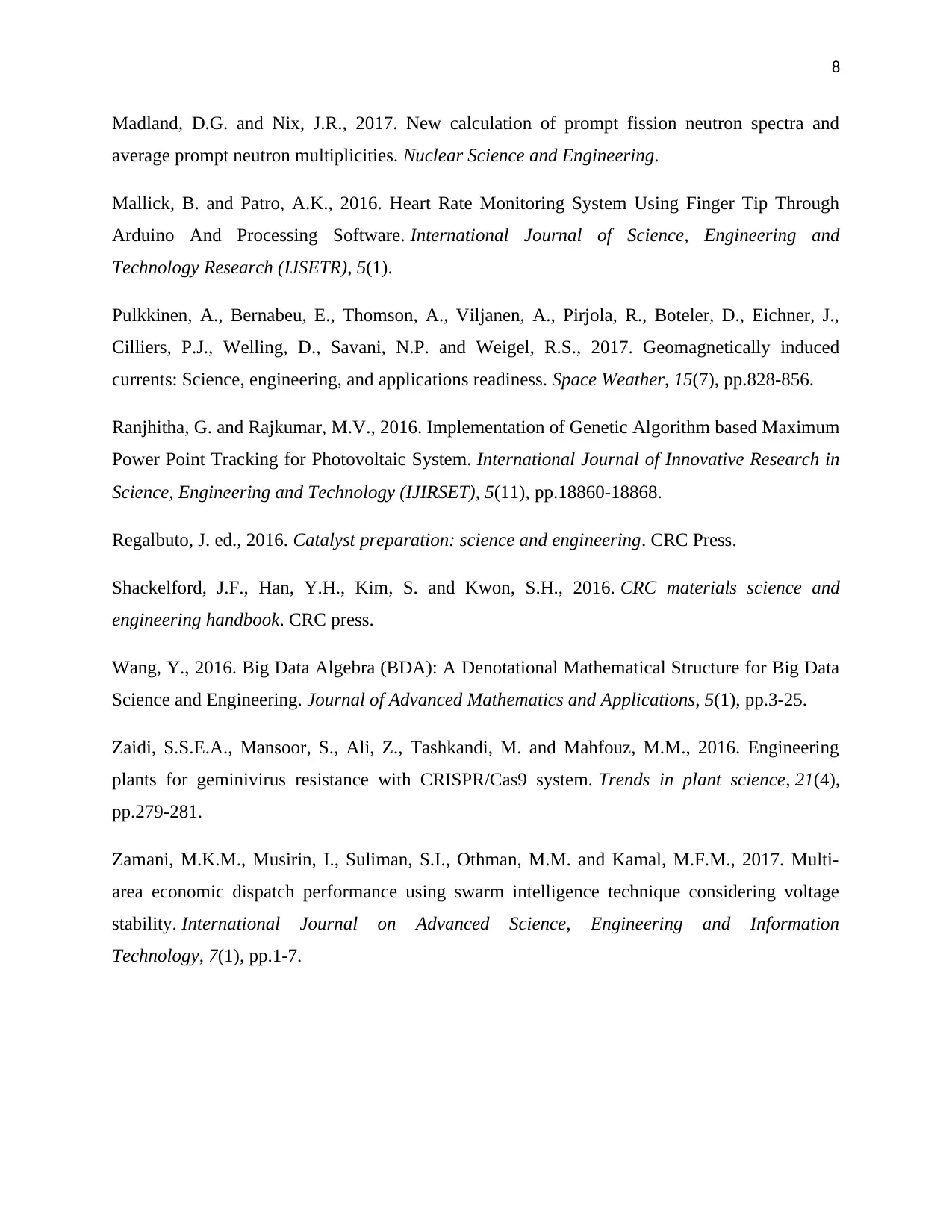
8
Madland, D.G. and Nix, J.R., 2017. New calculation of prompt fission neutron spectra and
average prompt neutron multiplicities. Nuclear Science and Engineering.
Mallick, B. and Patro, A.K., 2016. Heart Rate Monitoring System Using Finger Tip Through
Arduino And Processing Software. International Journal of Science, Engineering and
Technology Research (IJSETR), 5(1).
Pulkkinen, A., Bernabeu, E., Thomson, A., Viljanen, A., Pirjola, R., Boteler, D., Eichner, J.,
Cilliers, P.J., Welling, D., Savani, N.P. and Weigel, R.S., 2017. Geomagnetically induced
currents: Science, engineering, and applications readiness. Space Weather, 15(7), pp.828-856.
Ranjhitha, G. and Rajkumar, M.V., 2016. Implementation of Genetic Algorithm based Maximum
Power Point Tracking for Photovoltaic System. International Journal of Innovative Research in
Science, Engineering and Technology (IJIRSET), 5(11), pp.18860-18868.
Regalbuto, J. ed., 2016. Catalyst preparation: science and engineering. CRC Press.
Shackelford, J.F., Han, Y.H., Kim, S. and Kwon, S.H., 2016. CRC materials science and
engineering handbook. CRC press.
Wang, Y., 2016. Big Data Algebra (BDA): A Denotational Mathematical Structure for Big Data
Science and Engineering. Journal of Advanced Mathematics and Applications, 5(1), pp.3-25.
Zaidi, S.S.E.A., Mansoor, S., Ali, Z., Tashkandi, M. and Mahfouz, M.M., 2016. Engineering
plants for geminivirus resistance with CRISPR/Cas9 system. Trends in plant science, 21(4),
pp.279-281.
Zamani, M.K.M., Musirin, I., Suliman, S.I., Othman, M.M. and Kamal, M.F.M., 2017. Multi-
area economic dispatch performance using swarm intelligence technique considering voltage
stability. International Journal on Advanced Science, Engineering and Information
Technology, 7(1), pp.1-7.
Madland, D.G. and Nix, J.R., 2017. New calculation of prompt fission neutron spectra and
average prompt neutron multiplicities. Nuclear Science and Engineering.
Mallick, B. and Patro, A.K., 2016. Heart Rate Monitoring System Using Finger Tip Through
Arduino And Processing Software. International Journal of Science, Engineering and
Technology Research (IJSETR), 5(1).
Pulkkinen, A., Bernabeu, E., Thomson, A., Viljanen, A., Pirjola, R., Boteler, D., Eichner, J.,
Cilliers, P.J., Welling, D., Savani, N.P. and Weigel, R.S., 2017. Geomagnetically induced
currents: Science, engineering, and applications readiness. Space Weather, 15(7), pp.828-856.
Ranjhitha, G. and Rajkumar, M.V., 2016. Implementation of Genetic Algorithm based Maximum
Power Point Tracking for Photovoltaic System. International Journal of Innovative Research in
Science, Engineering and Technology (IJIRSET), 5(11), pp.18860-18868.
Regalbuto, J. ed., 2016. Catalyst preparation: science and engineering. CRC Press.
Shackelford, J.F., Han, Y.H., Kim, S. and Kwon, S.H., 2016. CRC materials science and
engineering handbook. CRC press.
Wang, Y., 2016. Big Data Algebra (BDA): A Denotational Mathematical Structure for Big Data
Science and Engineering. Journal of Advanced Mathematics and Applications, 5(1), pp.3-25.
Zaidi, S.S.E.A., Mansoor, S., Ali, Z., Tashkandi, M. and Mahfouz, M.M., 2016. Engineering
plants for geminivirus resistance with CRISPR/Cas9 system. Trends in plant science, 21(4),
pp.279-281.
Zamani, M.K.M., Musirin, I., Suliman, S.I., Othman, M.M. and Kamal, M.F.M., 2017. Multi-
area economic dispatch performance using swarm intelligence technique considering voltage
stability. International Journal on Advanced Science, Engineering and Information
Technology, 7(1), pp.1-7.
1 out of 8
Related Documents
Your All-in-One AI-Powered Toolkit for Academic Success.
+13062052269
info@desklib.com
Available 24*7 on WhatsApp / Email
![[object Object]](/_next/static/media/star-bottom.7253800d.svg)
Unlock your academic potential
Copyright © 2020–2025 A2Z Services. All Rights Reserved. Developed and managed by ZUCOL.


![Project Management Fundamentals and Practices Report - [University]](/_next/image/?url=https%3A%2F%2Fdesklib.com%2Fmedia%2Fimages%2Ffn%2Fcc45fac9bb8e435ca795906f2caf1048.jpg&w=256&q=75)


